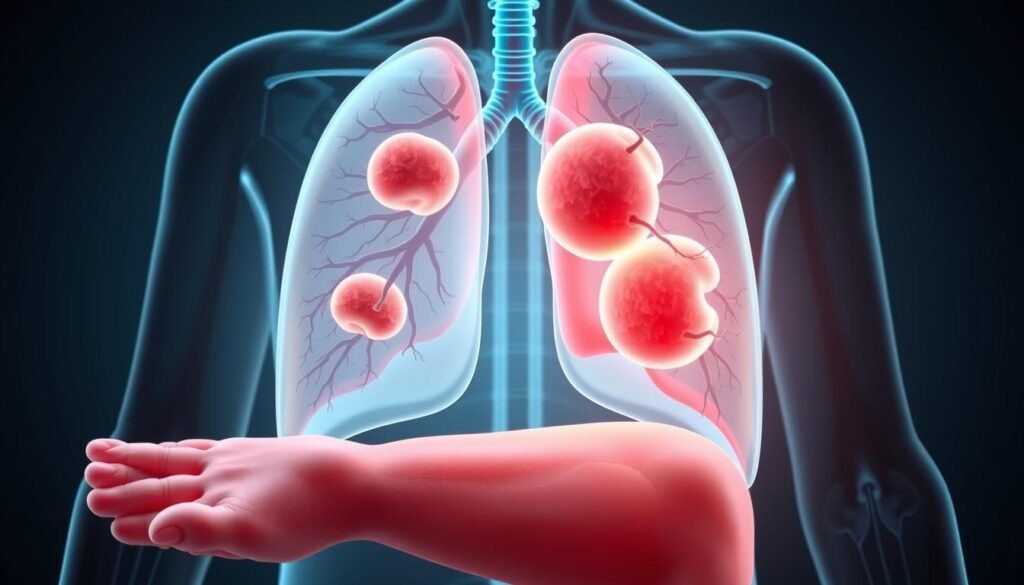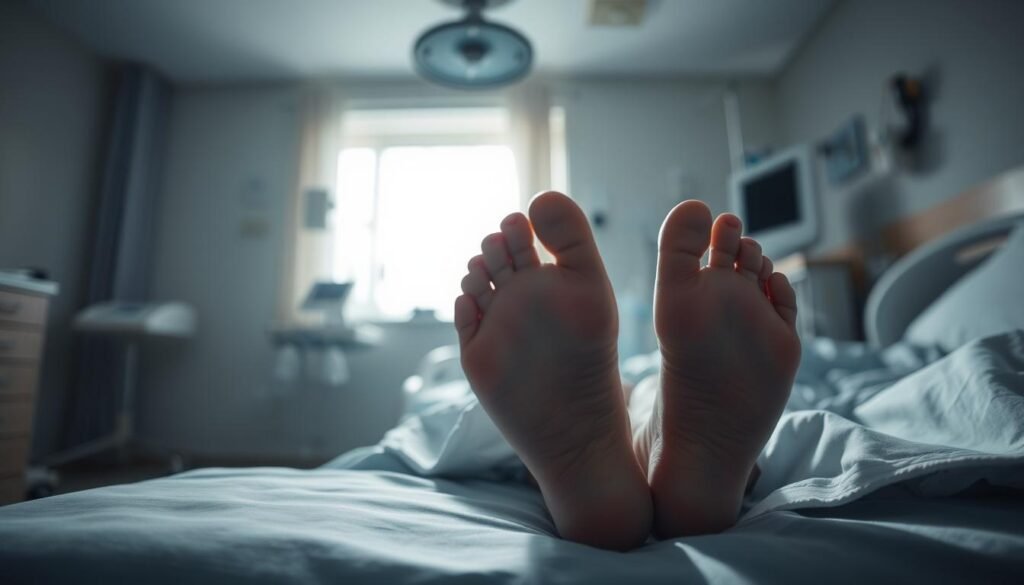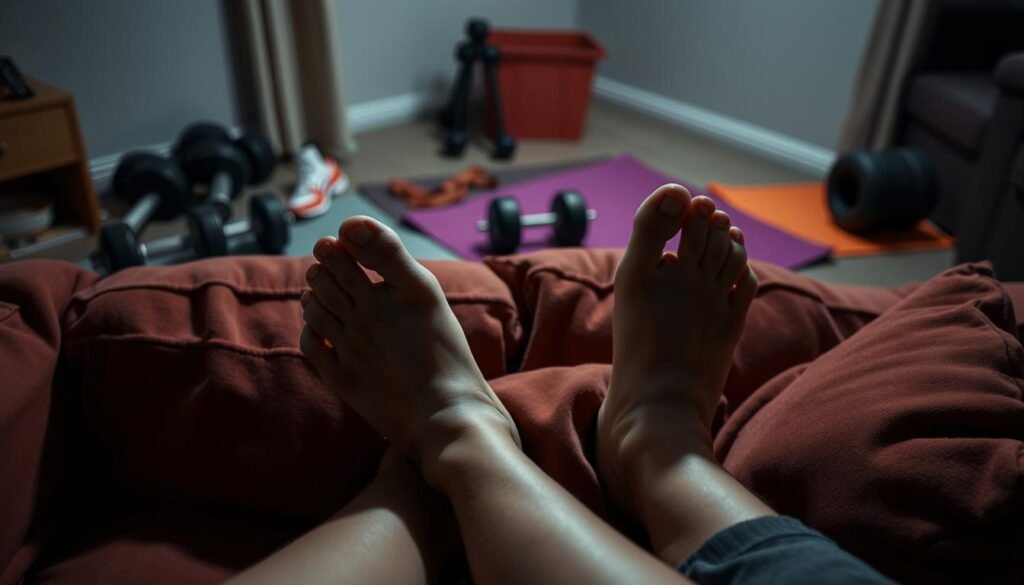Did you know swelling in the legs or feet can signal lung cancer in some people? This unexpected sign shows a link between lung cancer and edema. It highlights how crucial early symptom recognition is. Swollen feet in lung cancer patients may come from the tumors, treatments like chemotherapy, or surgery. Knowing why and how these factors cause edema is key for handling it and improving health.
Key Takeaways
- Swollen feet can be an early symptom of lung cancer.
- Factors contributing to edema in lung cancer patients include tumors, treatments, and lack of movement.
- Compression stockings may help manage swelling but should be discussed with a healthcare provider.
- Regular movement and dietary changes can aid in reducing edema.
- Seek medical attention for severe swelling or additional concerning symptoms.
Understanding Edema and Its Connection to Lung Cancer
Edema is when fluid builds up in body tissues, leading to swelling. This usually happens in the feet, legs, and ankles. It’s known as peripheral edema when it affects the limbs. It’s crucial for lung cancer patients to understand edema for better management.
Swelling can come from many sources, including lung cancer treatments. Medications often increase fluid levels, causing swelling in arms and legs. Lung diseases can also make swelling more likely, especially if the heart or kidneys are involved.
For lung cancer patients, swelling might mean the disease is getting worse. Conditions like chronic obstructive pulmonary disease (COPD) can cause fluid to build up in the legs and feet. This swelling can make your skin puffy, tender, and leave marks from tight shoes.
Keeping an eye on swelling is key for early action. Doctors diagnose edema by examining patients and running tests. Finding the root cause early on can lead to better treatments for fluid buildup.
What Causes Lung Cancer Swollen Feet?
Lung cancer swollen feet can happen for a few reasons. Lung cancer tumors can press on lymph vessels, blocking fluid flow. This blockage leads to lymphedema. Lymphedema means lymph fluid builds up, causing swelling in the feet.
Treatments like chemotherapy and steroids are often used. They can make the body hold onto extra fluid, causing swelling. Surgery to remove lymph nodes can also interrupt fluid movement, adding to the problem.
Not moving around much can make swelling worse too. It’s important to understand all these factors. Knowing helps with managing and treating swollen feet in lung cancer.
Identifying Symptoms of Swollen Feet in Lung Cancer Patients
Foot swelling in lung cancer patients is a serious sign. It’s vital to recognize symptoms of swelling early. Symptoms include heaviness in the feet, puffy skin, and pain during movement. The feet may look shiny and feel tight.
In lung cancer, swelling might be caused by tumors pressing on lymph systems or treatment reactions. This can lead to further health issues quickly. For example, it can make everyday tasks hard due to reduced mobility.
It’s important to keep track of symptom changes. Health professionals urge reporting new or worse symptoms right away. Not doing so could miss early treatments, making matters worse. A case study showed lung cancer worsening because of such delays. For more information on lung cancer and its complications, visit this resource.
Role of Lung Cancer Tumors in Swelling
Lung cancer tumors greatly affect swelling in patients. They can block the lymphatic system as they grow. This blockage increases lymphatic pressure, leading to swelling, especially in the legs and feet. It’s key to understand how this swelling happens to manage symptoms well.
The pressure from lung cancer tumors can cause swelling in specific areas, known as edema. This link helps healthcare providers figure out how to treat patients. For example, reducing tumor pressure may lessen edema.
Patients with swelling from lung cancer should seek medical advice. This can help improve their quality of life. Reading articles about lung cancer complications, including swelling, offers insights into management plans. These are found in discussions about lung cancer related swelling.

Impact of Lung Cancer Treatments on Foot Swelling
Lung cancer treatments can affect the body in many ways, especially the feet. Many patients notice their feet swell. This happens after treatments like chemotherapy, immunotherapy, and using steroids. These treatments can make the body hold onto more fluid.
Steroids make this problem bigger by causing more fluid to build up in your body. It’s key for patients and doctors to understand this. This knowledge can help manage the swelling better.
It can be hard to see the link between chemotherapy and swelling in the feet. But it’s important for those getting lung cancer treatments to watch for any changes. Finding swelling early helps in managing it well. It helps when patients tell their doctors about swelling or pain.
Immunotherapy can work well against cancer but might also cause swelling. This includes swelling in the feet. Knowing that these treatments can cause such side effects helps doctors care for their patients better.
Lung cancer treatments greatly impact foot swelling. Keeping an eye on symptoms and talking about them makes a huge difference. By learning about how treatments cause swelling, patients can improve their health.
Lung Cancer Surgery and Swollen Feet
Lung cancer surgery often means removing lymph nodes, which can affect the body’s lymph system. This may lead to swelling, especially in the feet. After nodes are removed, the lymph system might not drain fluid well, causing swelling.

After lung cancer surgery, patients might face issues like fatigue, pain that lasts for months, and breathing problems. Infections could also happen, making swelling worse.
There is also a risk of blood clots after surgery. Less movement can cause deep vein thrombosis. This could lead to serious problems like pulmonary embolism, with chest pain and short breath. It’s important to watch for swelling closely after surgery.
Managing the swelling after surgery is key. Knowing about lymphedema stages helps. It starts with no swelling (Stage 0) and can get more serious. Early stages might not need treatment, but later stages can affect walking.
After surgery, moving lightly helps reduce swelling and aids recovery. Health pros might suggest exercises to help with lymph flow and fluid management.
| Stage of Lymphedema | Description |
|---|---|
| Stage 0 | Swelling has not yet developed. |
| Stage 1 | Lymphedema may resolve without treatment. |
| Stage 2 | Tissue fibrosis may cause hardness or sponginess. |
| Stage 3 | May lead to an inability to move the affected limb. |
Understanding lung cancer surgery and its swelling effects is crucial. Quick attention to swelling helps patients heal better and improves life quality after surgery.
Other Health Conditions That Contribute to Swelling
People with lung cancer often face foot swelling due to other health problems. Conditions like cardiovascular disease and chronic kidney issues affect how the body manages fluid. For example, heart failure can block good blood flow, leading to swelling in the feet and ankles.
Some medicines for related health troubles can cause swelling, too. Drugs such as vasodilators and calcium channel blockers are common culprits. Reading about these causes is important for total care. It makes sure doctors check all possible unrelated swelling causes during treatment. Understanding these causes helps a lot.
Diabetic people can get skin infections, making swelling worse. Managing it gets harder for those with lung cancer. Also, those with kidney problems may see their limbs swell because of fluid keeping.
Below is a table summarizing common health conditions that may cause swelling:
| Condition | Impact on Swelling |
|---|---|
| Cardiovascular Disease | Impedes blood circulation, leading to edema. |
| Kidney Condition | Reduces fluid elimination, causing swelling in legs and feet. |
| Diabetes | Increases risk of skin infections that can cause swelling. |
| Medications | Some drugs can lead to fluid retention and swollen extremities. |
Looking closely at these conditions is key to treating lung cancer patients better. Understanding how these health problems interact helps give complete care. It’s crucial for the best overall treatment.
Lack of Exercise and Its Effects on Swelling
Not exercising enough can affect how the body deals with swelling, especially with lung cancer. Staying still too much makes fluids build up in the limbs, causing foot swelling. When people feel tired and sore, as often happens with cancer, they move less.
Doing some gentle movements can really help with swelling. Things like stretching, taking short walks, and moving your ankles are good. These activities improve blood flow and help with lymph drainage.
Light exercises can make life better for patients. Activities like fast walking, yoga, or tai chi are good choices. They don’t just lessen swelling. They also make overall health better. Telling patients about the benefits of regular exercise can inspire them to look after their health more.

Managing Lung Cancer Swollen Feet
To manage swollen feet in lung cancer patients, we focus on the main causes. Regular exercise is key. It boosts circulation and reduces swelling. Raising the feet helps too. By doing this, fluid drains better thanks to gravity.
Eating less salt is crucial. It helps prevent too much fluid buildup. Foods low in salt are good for controlling swelling and staying healthy. Compression garments also help a lot. They press evenly and make blood flow better, which lessens swelling.
Meeting regularly with your doctor is important. Together, you can come up with a plan that meets your personal needs. This plan may include how to handle pain, tiredness, and your overall health. Working closely with your healthcare team makes handling swelling easier. It improves the way we care for patients.
Dietary Changes to Reduce Swelling
Changing your diet is key to managing swelling, known as edema. Cutting back on salt is essential because it affects how much fluid your body holds. Eating too much salt can make swelling worse, especially for people with lung cancer.
Eating right can ease edema symptoms. You should:
- Aim for at least two and a half cups of fruits and vegetables per day.
- Add protein-rich foods to strengthen connective tissues.
- Keep sodium low to better manage swelling.
- Drink more water. Women should have 2.7 liters (91 oz) and men 3.7 liters (125 oz), as recommended by the Institute of Medicine.
Magnesium-rich foods are also good for you. Eat more nuts, seeds, legumes, whole grains, and green leafy veggies. They help with water retention and swelling. You might even consider magnesium supplements, especially if you don’t get enough from food. Always check with a doctor for the right dose, usually 200 mg to 400 mg daily.
Regular exercises like walking or swimming boost the benefits of your diet in fighting edema. They help fluid move in your body and keep your weight healthy. A healthy weight can decrease the risk of lymphedema. This risk is lower when you combine exercise with the right diet.
By focusing on these strategies, people with swelling, including those with lung cancer, can better manage edema. It’s important to modify your diet to fit your needs, maybe with help from a nutritionist.
| Food Group | Recommended Daily Servings | Benefits |
|---|---|---|
| Fruits & Vegetables | 2.5 cups | High in fiber and essential nutrients, support hydration. |
| Protein | Varies | Maintains connective tissue health, crucial for edema management. |
| Water | 2.7L (women), 3.7L (men) | Essential for fluid balance, helps reduce swelling. |
| Magnesium-Rich Foods | Incorporate regularly | Aids in water retention management; may help reduce swelling. |
Compression Garments and Their Effectiveness
Compression garments are key in handling swelling, especially for lymphedema patients. These special stockings and wraps apply pressure on legs, helping reduce mild to moderate swelling. The effectiveness of these garments is based on their ability to stop fluid from building up in tissues.
Having the right fit for compression garments is crucial. A lymphoedema specialist often measures patients every six months for the best fit. These garments have different levels of pressure, from mild to firm. This helps those at risk for lymphedema. You can choose from knee-highs, thigh-highs, and pantyhose for your comfort and style.
- Graduated compression stockings are made to give the most pressure at the ankle and less as they go up to the knee.
- Compression wrap systems use fabric bands with Velcro for a fit that’s right for you.
- Men with swelling in the genital area might need special garments.
- Multi-layered bandaging can help manage swelling for a short time with daily use.
- Exercise during treatment can move lymph fluid and improve therapy effectiveness.
It’s important to keep your compression garments in good shape; replace them about every six months. This step is key in managing lymphedema well, improving life quality for those with leg swelling. Knowing how to use and take care of these garments avoids issues and lets users get the most benefit.
When to Seek Medical Attention for Swelling
Swelling can be a sign of major issues, especially in lung cancer patients. It’s crucial to watch out for serious symptoms. Don’t ignore sudden or severe swelling. If you have pain, skin changes, or get short of breath with swelling, seek medical attention right away.
Edema mainly affects legs, ankles, and feet due to gravity’s pull. But, it can happen in other body parts too. Waking up with swelling, peeing less, or having bubbly urine needs checking out. These signs could mean heart failure or lung cancer complications.
If swelling sticks around after you travel or sit too long, see a doctor. Conditions like deep vein thrombosis are dangerous but might not show symptoms. The Mayo Clinic says to get checked for sudden leg swelling without an obvious reason, especially if you’ve been hurt.
Knowing when to get help can change how lung cancer treatment goes. Acting fast means better management options. This can really help improve life for someone fighting lung cancer.
| Symptoms to Watch For | Recommended Actions |
|---|---|
| Sudden swelling in legs | Seek immediate medical assistance |
| Swelling with shortness of breath | Contact a healthcare provider urgently |
| Persistent edema upon waking | Schedule a doctor’s visit |
| Decreased urination or foamy urine | Get evaluated for potential kidney issues |
| Leg pain after inactivity | Consult a physician to rule out clots |
Conclusion
Knowing how lung cancer connects to swollen feet is key for better care and life quality. Lung cancer causes swollen feet due to tumors, treatment side effects, and lifestyle changes. These factors affect the patient’s health, causing fluid to build up and discomfort.
Patients facing this tough journey should have a detailed care plan. It should focus on managing symptoms, eating right, and staying active. Such approaches help deal with lung cancer’s effects and offer needed support. It’s important to be aware and catch these signs early for quick help.
In short, understanding lung cancer’s effects on the body, like swollen feet, is crucial. It helps patients and caregivers make smart choices. This approach helps ease physical pain and supports mental health during this hard time.